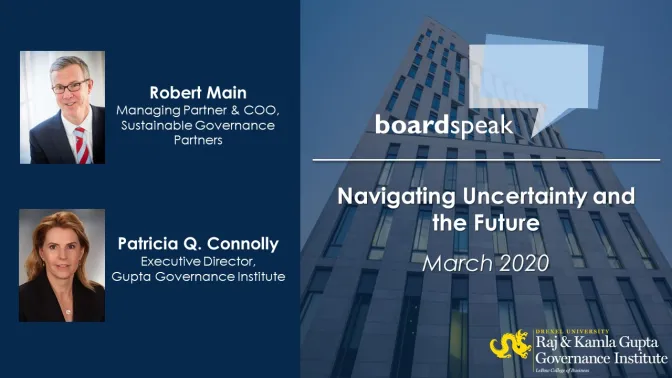
The New Era of Governance
“The trick is to build the board for the future, not the past.” -Non-profit Director and Institutional Investor
For the past decade, boards have undergone a slow, but deliberate evolution towards a new model of governance. If one needed proof of this transformation, you need only listen to the nature of discussion among board members at gatherings and events. In the not too distant past, investors and external advocates were often the sole voice for issues while also promoting the increased responsibility of directors. Now, these conversations are led by directors themselves who are encouraging change in the boardroom, motivated by the knowledge that the best party to enact change are the directors themselves.
While this new level of engagement is not true of all directors, what is clear is that there is a thoughtful and robust debate taking place about the quality, quantity, and speed of change in response to the evolving business environment in which boards are operating.
This article is based on the 2019 Directors Dialogue, convened by the Raj and Kamla Gupta Governance Institute at Drexel University on April 16, 2019. In its eleventh year, the 50 participants included leading directors, investors, and governance practitioners representing 49 public, 39 private, and 49 nonprofit boardrooms from across the country employing over 3 million people and $1.54 trillion in market cap.
Better Engagement, Broader Engagement
One of the clear benefits of recent governance developments resulting from the increased engagement between boards and investors has been the development of stronger relationships and a better understanding of each other and the key issues and concerns that they each hold. But as a sitting SEC commissioner noted, boards have an opportunity to go further and help educate others. In particular, the Commissioner observed that policy discussions in Washington, DC often only cover a “slice” of the reality. The voice of directors is often underrepresented in policy discussions and, therefore, policy decisions. In his remarks, the Commissioner invited directors to visit with regulators and others in DC and encouraged them to expand their engagement to include policymakers.
This is a critical moment for directors to help regulators and others to understand the board’s view and the perspective of their companies. Recent governance failures have led to increased pressure on federal regulators to become even more involved in the governance debate. The concept of environment, society and governance, or “ESG”, and materiality are under active discussion. In this context, boards are trying to figure out how best to respond. Ensuring that the fundamentals of governance are in place is a critical first step. Boards should not get distracted by this increasing pressure, but instead must fulfill their core role correctly and use the outreach as an opportunity to educate, inform, and listen to various constituencies.
At the same time, boards should be thinking about how to get in front of the various issues that they confront by setting their own agenda. While a topic of frequent discussion, the DEF 14A Annual Proxy Statement is an important tool to leverage. There is an opportunity for boards to rethink the proxy statement—how and what they communicate through it to their investors and others. With the proxy statement positioned as the broadest communication tool, boards can then build their engagement plan from that, being deliberate and thoughtful about their engagement.
What is clear is that engagement, which has been on the rise for the last decade, will only continue to increase. As directors grow more comfortable with their expanded board roles, which increasingly involve direct communications with investors and others outside parties, the calls for them to meet with investors and others will grow, and so will the need for directors to be confident in their company’s strategy and the board’s decision making processes.
Setting the Board’s Agenda for the Long-Term
“The challenge for boards is to be more proactive and ‘claim some space’” – Director of a Fortune 10 company
Directors must “get in front” of issues by actively addressing and forecasting the emerging areas that investors and the public are raising. But this response has to be a part of the company’s broader strategy, and that places renewed emphasis on getting strategy right. In the context of the current short-term/long-term debate and the evolving focus on ESG issues, boards need to be clear on what role they are going to play.
While it is true that each company is unique—private versus public, mature versus start-up—boards should take the lead with management to think through and plan for the long-term. The trick for boards is to get the mix right, focusing on strategy and ensuring execution, looking at risk, capital allocation, and talent. Long-term strategy is not a “set it and forget it” approach, rather it is both art and science that requires constant rethinking and revisiting of assumptions and recalibrating to dynamic market conditions.
Without a doubt, the board’s agenda has grown more complex. Regulatory requirements have been compounded with the new issues of ESG. With the growing sentiment that government has failed to address critical social issues, companies are increasingly under pressure to play a role in the solutions. To help manage this complexity while also building trust with investors, directors should consider focusing on these emerging issues and taking an active role in learning about them, while also ensuring the board only reacts on those issues that truly impact the company’s long-term success.
The Private/Public Divide
“If you’re going to make a big decision, you can’t get it wrong” – CEO of a Fortune 50 Company
For several decades, public and private company boards were treated as entirely different types of organizations. As such, it was rare that the differences between public and private boards, and what one could learn from the other, was considered. With the challenges that companies—both public and private—face in the current environment and the changing expectations of boards, this divide is being revisited. Increasingly, private boards are being recognized for their strength in responding to changing conditions, their discipling around capital allocation, and their strong accountability of CEO performance. Understanding how those competencies can be transferred into the public company governance model is a topic of active discussion, particularly among directors that serve on both public and private boards. Recognizing the importance of alignment of compensation and ownership interests, discussions also focus on the nomination and onboarding processes. As boards revisit their nominating process and look for profiles that bring fresh and relevant experience, bringing private company executives to public company boards holds great potential.
A similar conversation also looks at the balance of oversight versus operational engagement, a key difference in the governance models of public and private boards. While continuing to respect the role of management, public company boards are actively looking to find more substantive ways to engage with management on the business so as to better understand what is happening within the company and how that impacts the long-term strategy. At the same time, some public company directors also acknowledge that private company boards have historically been more effective when it comes to making important management changes when necessary, enabling, some argue, more agile companies.
At the same time, there is a general sentiment that part of what has taken place is the “over-thinking” of governance in the public company context. The focus on process and compliance has, some argue, crowded out business judgment and the ability to act quickly and decisively. Examples often pointed to include quarterly reporting, which requires significant board and management time, and the increased compliance requirements on the board which take up a disproportionate amount of time on the agenda. It comes down to a fundamental debate about the core role of the board – as a body that manages risk or that creates long-term value. While the answer is clearly both, the balance of those to roles will be the difference between a successful board and a failed one.
Where the Discussion Goes From Here
The past approach of wait-and-see on outside interest and pressure on boards is no longer an option for directors. Now, directors are not focused on whether, but how to best engage on these issues, recognizing that the focus on governance and the role of the board will only increase. And so, the only question for boards is how they will behave in that environment.
In the past, boards were positioned as having oversight of management and holding management accountable. In this new environment, many directors are focused on positioning the relationship as more collaborative—a partnership between management, which is responsible for execution and has much more information than the board, and the directors, who bring a broad set of experiences to the table. This partnership is predicated on an open and respectful exchange of ideas, testing assumptions and reframing issues in the right context. As boards confront more complex operating environments, with increased risk from new areas like ESG and competitive disruption, and as boards expand their focus from CEO selection to areas like strategy and culture, creating a new dynamic among the board allowing for directors to contribute their full experience and that set directors and boards as partners holds the potential to enable business to address the challenges they face and realize the opportunities before them.
The Gupta Governance Institute advocates for improved governance practices for public, private and nonprofit organizations.
The Center's research and programmatic efforts advocate for leading governance practices in the public and private sectors.

